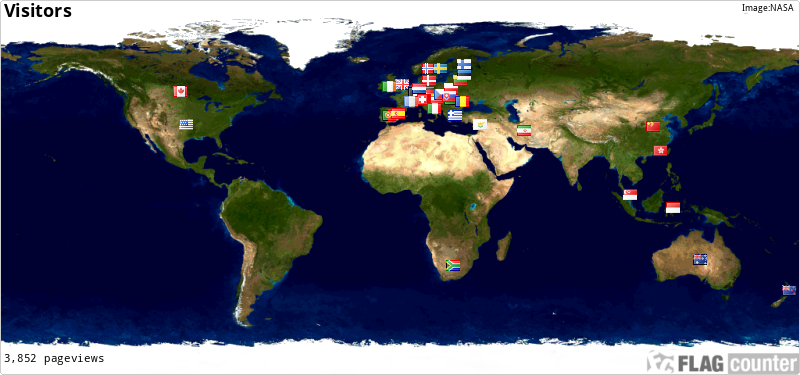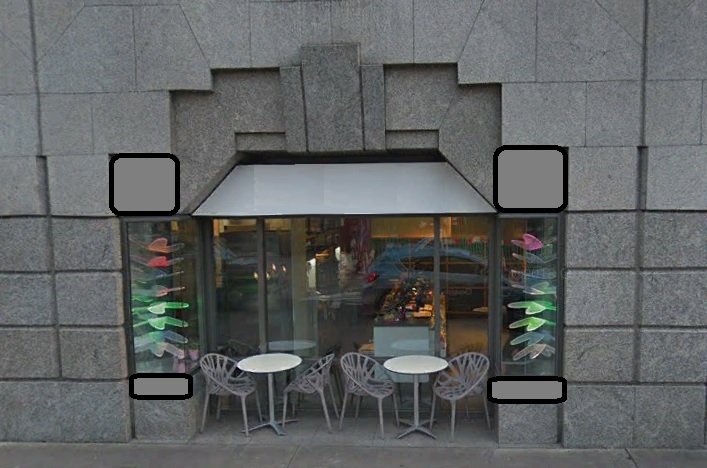
**Use the header photo / read the hint to study the correct stone!!**
**This cache is located within an area frequently patrolled by Police. Please avoid acting suspiciously whilst searching for it, and if challenged, explain about geocaching. It may be worth pointing out that it is not a physical box you are looking for, but are simply studying the rocks visible to everyone.**
The learning point of this earthcache is to get the geocacher to become familiar with the Igneous rock Syenite.
Igneous Rocks
Let`s do a little bit of review before we look into the igneous rocks. There are so many different types of rocks to be found around the world. And they all belong to one of the three types: Igneous, Sedimentary or Metamorphic rocks. The igneous rocks are formed from volcanic activity. This means they are either created from cooled magma or cooled lava. The difference between magma and lava is its location - interior versus exterior. (See illustration)
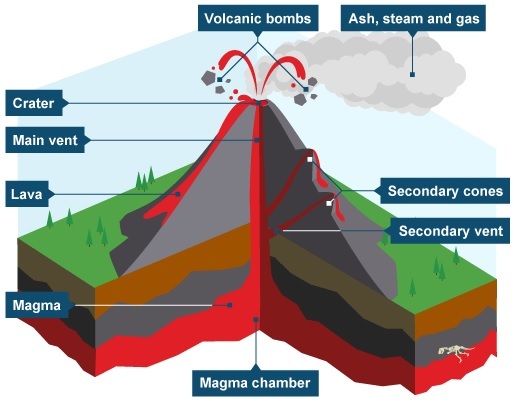
Magma is the molten rock found inside the crust of the earth. Pockets of magma come up from the mantle/main vent and push their way through weak spots and vents in the earth's crust, often under volcanoes. When magma is pushed up through a volcano that's erupting, the magma becomes lava as it exits out of the crater.

The distinction is important since there is a main difference between if the rock cools from lava or from magma, even that both are volcanic. The formation and difference we are talking about here is important because the rocks that come from magma become intrusive igneous rocks, and the rocks that come from lava become extrusive igneous rocks. The difference is due to how fast the material cools.
The cooling rates/process.
Since magma is located inside the earth, the overlying rock and sediment act as a blanket that keeps the magma warm and allows it to cool slowly. Lava, however, exits the volcano and cools much faster.
An easy way to see and understand this better is to explain the cooling rates by using baking as an example. After baking bread, you turn off the oven and allow the bread to cool before slicing. If you leave the bread inside the oven to cool, it does so very slowly. If you take the bread out of the oven and sit it on the counter to cool, it does so more quickly.
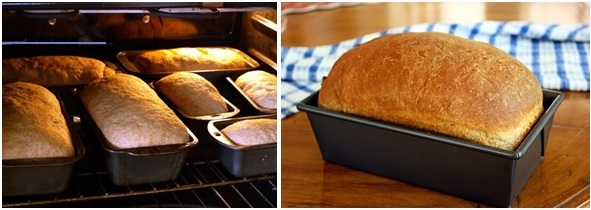
In rocks, the rate of cooling allows mineral crystals to grow, which make up the igneous rocks, to grow. The longer time the rock is allowed to cool, the bigger mineral crystals and grains we get.
Because the magma cools slowly, the ions have time to move around and form mineral crystals. As a result, when you have rocks that cooled from magma, you can easily see the different mineral crystals in the rock. These rocks are intrusive igneous rocks because they cooled slowly 'inside' the earth.
Because lava cools more quickly, there is not enough time for mineral crystals to form and grow, so you have rocks with very tiny mineral crystals that cannot be seen without the aid of a magnifier. These rocks are considered extrusive igneous rocks because they cooled quickly 'outside' the Earth.
Syenite is an igneous rock that solidified slowly in the crust in a similar manner to granite. A true syenite is also compositionally resembling granite. The most notable difference is the absence or very low quantity of quartz while it is an essential component of granite. The dominant mineral is alkali feldspar, usually orthoclase. This rock type is found in a wide variety of colors.
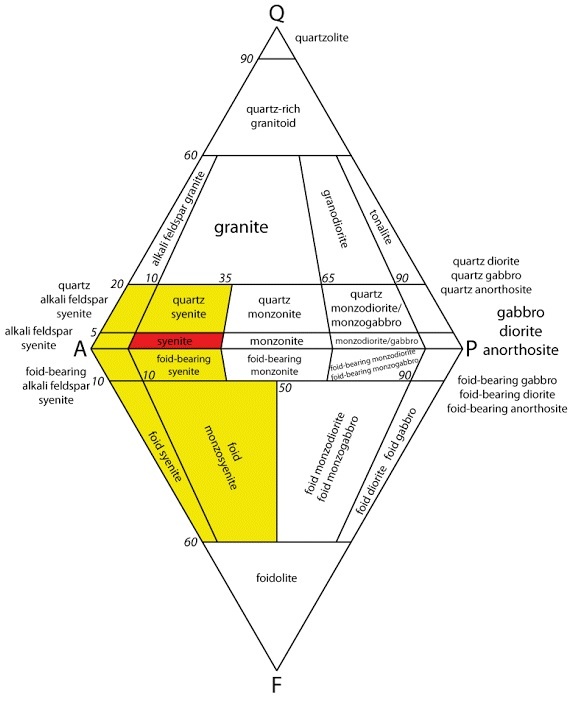
Classification (QAPF) diagram. Different syenitic rock types cover large part of the diagram. The true syenites are rocks that fit into the area annotated in red.
The diagram above may give the impression that the syenite is a relatively insignificant part of the whole family. This is not true. Syenite and quartz syenites as well are the most common of the whole group, although syenite is a relatively rare rock type, especially when compared with granite or other granitoids.
It is alkali feldspar that forms the majority of most syenitic rocks and is usually intergrown with sodium-rich plagioclase feldspar, usually oligoclase. Such feldspar intergrowth is named perthite and this is the reason why syenite is more common rock type than alkali feldspar syen. which contains almost no plagioclase. Plagioclase may appear in syenitic rocks in addition to perthitic alkali feldspar also as a separate phase. Dark mica biotite and amphibole hornblende are usual mafic constituents. Alkali syenites may contain somewhat unusual minerals like aegirine, arfvedsonite, etc. Common accessory minerals are zircon, apatite, sphene, magnetite, and ilmenite.
Syenitic rocks are usually associated with other plutonic rocks. They form relatively small intrusive bodies or parts of larger intrusions. Most syenitic seem to be associated with extensional tectonic regime, the rifting continents. Some of them are believed to be fractionation products of alkali-rich basaltic magmas, but there are several different mechanisms responsible for the genesis of a syenitic magma. In this sense it is again similar to granite which is also defined solely by its mineralogical composition although there are very different possible ways how granitic magma can evolve. It is perhaps inevitable because minerals are something we can determine, unlike genesis which in many cases is still a mystery.
The best known unofficial names of syenite varieties are foyaite, canadite, durbachite, umptekite, nordmarkite (quartz syen.) and perthosite (alkali feldspar syen.)

To log this cache.
To get to log this cache you will have to visit and answer the questions which are related to the coordinates given the earthcache.
When answers are collected, send them to CO for verification.
You can log immediately after answers are sent CO. If there are any questions about your answers CO will contact you.
Logs without answers to CO or with pending questions from CO will be deleted without any further notice.
Please do not include pictures in your log that may answer the questions.
Questions:
1. Answer the questions under by visiting the Coordinates.
A. A-1) Go to the coordinates and study the Syenite closely. How big in mm are the crystals in the stone, and what mineral is the one with very low quantity found in the stone?
A-2) From what you have observed, do you think the Syenite is an intusive or extrusive igneous rock, describe.
B. By visiting the coordinates, tell what picture, (from above in the text) that is from ground zero? (A, B, C or D)? Describe the color(s).
C. Which mineral is dominating the stone?
2. (It’s voluntary to post a photo in your online log of your visit)
